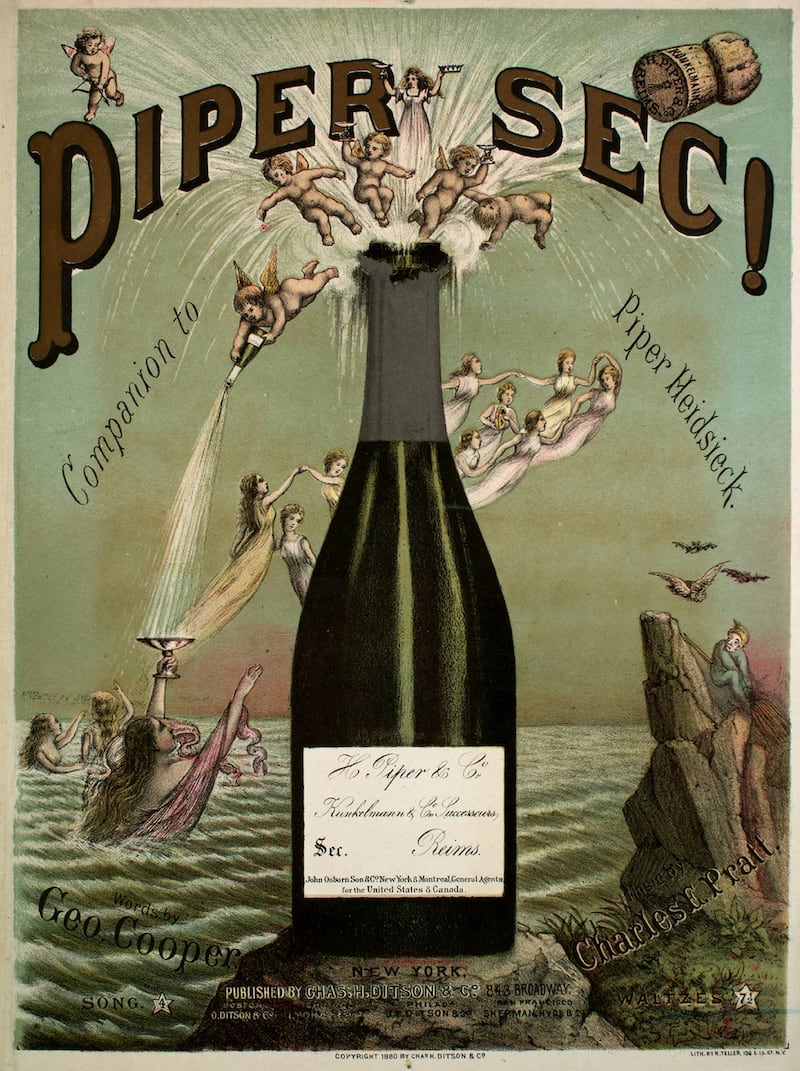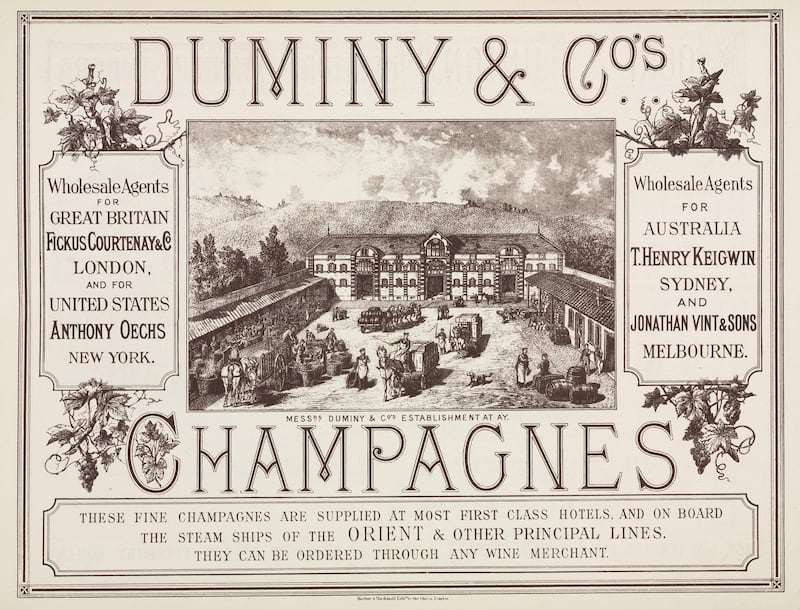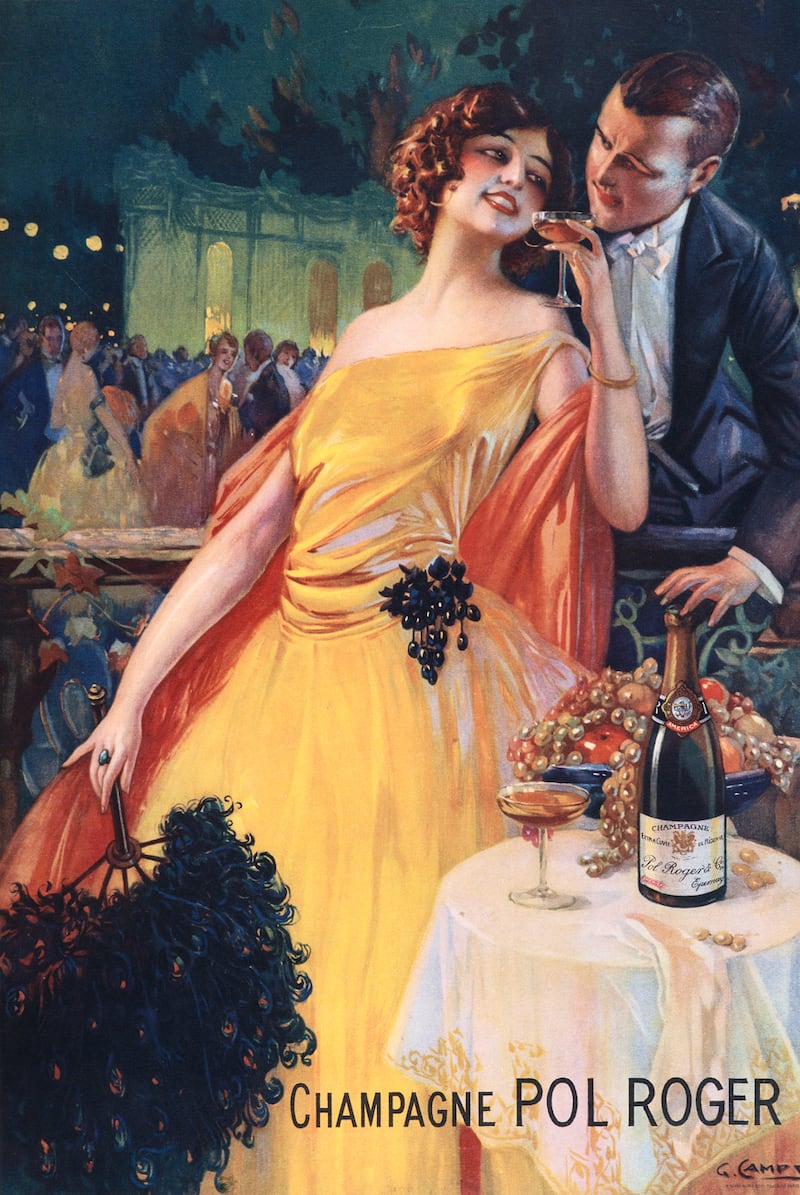“Come quickly, I am tasting the stars!” – 19th-century advertisement (though often attributed to Dom Pérignon)
Romance is not bound by social class, though for most of its history, champagne, the drink toasted as the world’s most romantic, has been the reserve of the wealthy elite. These romantic and valiant connotations stretch back to the late eighteenth century and were buoyed by forces of class and social taste, which further enhanced the status of champagne. Early in its history, the Champenoise associated their highly popular wines with French kings and nobility. Later, during post-revolutionary France, they sought unique and entrepreneurial ways to market their wines to the emerging middle classes of Europe.
Throughout the Belle Époque era (1871-1914), champagne was promoted on labels and posters with elaborate and colourful images of luxury, celebration and frivolity – in stark contrast to the conservative labels from other important wine regions. Bottle labels were decorated with homages to important life-moments, thus creating a powerful narrative and mythic aura around champagne.

Producers did not select one theme to promote their special wine; rather they sought a broad spectrum of events to reach into the hearts and minds of not only the affluent, but also those with a growing sense of national pride in all things French. Labels denoted major sporting events, New Year's Eve, the electrification of France, the political culture of the fin de siècle, and an overarching sense that champagne represented the best of l'art de vivre.
But it was the association with feminine themes that drew the most attention and cleverly made champagne a wine for both men and women. Whereas rich red wines from Bordeaux and Burgundy were seen as masculine and brooding, champagne had elegance, grace and flair. Its representations of love, purity and tenderness attracted women and young couples through enchanting images of engagement, flowers, marriage or the welcome birth of a child. This kind of romantic symbolism underpinned the universality of champagne and secured its status as the ultimate symbol of fashion, patriotism, ardour and distinction.
Although there have been numerous difficult periods in its history, the region of Champagne is nothing if not resilient. After every setback (strife, world wars and economic hardships) the region dusted itself off and got back to the important business of bubbles. Exports grew and the world fell in love with this one-of-a-kind wine.
Its social gravitas is palpable, from the royal courts of 18th-century Europe to the film sets of Hollywood, and all manner of salient occasions in between. Authors have used it to add verve to their prose, James Bond exudes sophistication through his knowledge of it and since the late 1970s champagne has become a constant reference in both the music videos and lyrics of R’n’B and Rap artists – all bling-bling but no romance. It has been criticised for its bravado and cost, while its prestigious name has been used and abused to market everything from perfume to chocolate.

Champagne can only come from the region of its namesake and its intellectual property rights are fiercely defended by those who produce it. Eager comparisons to other sparkling wines, intent on knocking champagne off its perch, have been drawn – cava from Spain, franciacorta and prosecco from Italy and, more recently, traditional-method sparkling wine from England. Global sales of prosecco may occasionally surpass those of champagne, but the two are simply not comparable in terms of the many complexities and celebrity of the latter. It remains the only wine where the names of its many champions (Dom Pérignon, Dom Ruinart, Veuve Clicquot, Jacques Bollinger et cetera) have passed into popular culture. The Benedictine monk, Dom Perignon, being the most mythologised of all. His wholehearted work did open the door for others to refine the quality, flavour, and precious bubbles of champagne – although he did not invent it, as is widely believed.
Just before the good old bad old days of 2008, Ireland was importing over a million bottles of champagne a year. This has fallen to less than half a million today, as the nation has chosen cheaper sparkling alternatives. Cost would appear to be a real barrier, and it is unfortunately true that some restaurants in Ireland price their champagne extortionately. Wine lists can be a minefield, and choosing what wine to drink can set off pangs of anxiety, especially when the occasion calls for something more than the cheapest or second cheapest. That said, much of our aversion to seeking out fine wine lies in the fear of making a bad choice.
Since the new confidence in Irish food and cooking has taken hold, Ireland is finally growing as a gastronomic nation, which not only consumes but cares about what it consumes. Appreciation for better wine is part of this transformation. It always starts with food – wine follows after. Through the insistence of sommeliers and some discerning producers, it has regained its place as a food-wine for serving throughout the meal. Its gustatory pleasures are not reserved for sipping alone! A bottle of good rosé champagne is a revelation when paired with savoury foods. What is in your glass is important, regardless of how commonplace wine has become. This is not an allegory about a wealthy nation that can afford to drink well but more about a nation that is falling in love with good wine. Supermarkets still sell the lion’s share here, much of it forgettable, but even they know that Irish tastes are changing.

With the vast selection available today, some of the romanticism of popping a cork has fizzled. We drink wine in all sorts of places, which has removed the ceremony once afforded it (some would say this is a good thing). A glass in front of the TV while watching Netflix might be relaxing, but it is hardly setting anybody’s heart racing – and yet there is something about champagne that supersedes the mundane. It signals a moment, a point of interest, and a reason to smile. We should seek out great wines that give us pleasure while being more than just a delivery mode for alcohol. Champagne very rarely disappoints! Notions of romance may be predicated on historical marketing, but champagne reminds us what it is that we really love about wine. And who doesn’t feel special when a glass is being poured for them?
Champagne is certainly misunderstood and deserves our attention more regularly. Why wait for rare and special occasions? If you love someone, and you know they love champagne, then make it the next bottle you share together. In addition, if you have never tried it, start and finish your next dinner of note with champagne. A bottle at the end of the night refreshes even the weariest soul, lifts the heart and cleanses the senses. Porta patet, cor magis…
Diarmuid Cawley lectures in Wine Studies and Gastronomy at the School of Culinary Arts and Food Technology, TU Dublin











